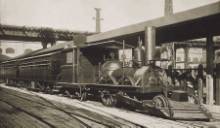John
Bull Steam Engine Info

1893 Columbian Exposition
|
John
Bull Steam Engine Info |
|
John Bull Dedication Day, Hicksville May 17th, 2008 |
||
Hicksville Chamber of Commerce John Bull 1831 Plaque Photo: Al Castelli |
Dedication view N Photo: Al Castelli |
John Bull driver detail Photo: Al Castelli. |
|
John Bull
- Wood
Construction |
||
 When I found the tree in upstate New York it was a
white Oak tree. It was timber from a tree growing in the 1820's/1830's.
time period (John Bull era) and came from Cayuga, NY, about 280
miles from Hicksville. The timber looked very good, but it did have
checks (apparent cracks and or imperfections in the timber). I used a
marine Epoxy that would be applied several times to insure penetration
and seal out any potential problems. It worked very well. It was done to
preserve the frame in and out of doors for display. I went over it until
it was solid. Then primed it twice and finish coated the Green. When I found the tree in upstate New York it was a
white Oak tree. It was timber from a tree growing in the 1820's/1830's.
time period (John Bull era) and came from Cayuga, NY, about 280
miles from Hicksville. The timber looked very good, but it did have
checks (apparent cracks and or imperfections in the timber). I used a
marine Epoxy that would be applied several times to insure penetration
and seal out any potential problems. It worked very well. It was done to
preserve the frame in and out of doors for display. I went over it until
it was solid. Then primed it twice and finish coated the Green.
The wheels were even more intensely considered.
The wheels are hickory and ash. The wheels were contracted for with the
famed wheel Wright -Jacob Witmer and his son Dale, in New Holland, PA.
We had many discussions and it took about $10,000.00 to construct
the wheels that were approx .(4) - 55" in Diameter and(2) - 28"
Cow Catcher. The wood was coated with boiled linseed oil and mineral
spirits. They were mixed at a 50/50 ratio. It was observed in our
discussions that the survival rates would be greatly enhanced following
this procedure. We did! The solution was applied with spray bottles and
left to dry for a week at a time and repeated the process three
times. The wheels were primed and painted . The Locomotive is set
30" above grade to insure the maximum snow drifts that average
24" would be able to protect the wheels from various forms of
precipitation.
We did the same procedure with the cab. It is our
intention to maintain the locomotive.
The engine was bead blasted and metalized by
Atlantic Coast Metalizing & Coatings Corporation, in Melville, NY.
The engine was then epoxy coated for longevity and final coat painted. I
believe we will be using a wax to preserve the finish and it is being
looked into. We expect to maintain the John Bull like an Airplane;
something I am very familiar with. It will be maintained 100%. It will
become the property of the Town of Oyster Bay on May 17th, and I
will need to complete a full comprehensive maintenance and facility
report to insure that maintenance is properly done and recorded.
I have taken the steps to insure that the
locomotive is properly constructed and maintained. Did I forget
something? It is possible, but as time moves on we will have the
knowledge to alter and make changes. It was built to last and it can be
said of other structures like the Verrazano-Narrows Bridge, "...if
properly maintained it will last a lifetime..."
I hope this sheds some light on the process we
considered. The information isn't generally spoke about as it is
considered behind the scenes and for those more deeply interested it is
posted here.
Photo: Carl Dimino - Jim Pavone speaking at the Hicksville Historical Society 190th Anniversary Tribute 10/08/2024 |
||
10/19/2024